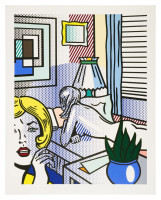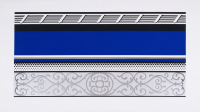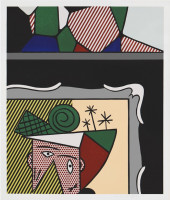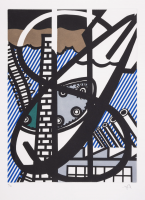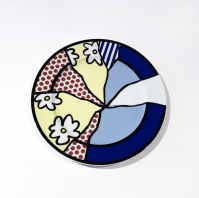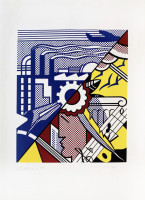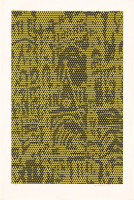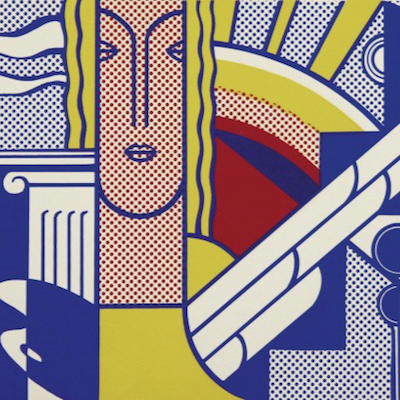
Details
Artist
Styles
Screenprint in colors on Lanaquarelle watercolor paper. Composition II (1996) by Roy Lichtenstein is a vivid screenprint that transforms musical notation into a bold, dynamic visual language. Rendered in his signature Pop Art style, the piece features swirling staves of sheet music interwoven with musical notes that appear to dance across the surface. The curving lines and intersecting forms create a sense of rhythm and movement, mirroring the flow of a musical composition. Lichtenstein incorporates hallmark elements such as Ben-Day dots, flat planes of primary color, and thick black outlines, blending abstraction with recognizable motifs. The work blurs the boundary between visual and auditory art, turning music into an image while retaining its expressive energy. Executed on Lanaquarelle watercolor paper in a limited edition of 50, this screenprint exemplifies Lichtenstein’s playful yet precise approach to visual structure and cultural symbols.
Composition II, 1996
form
Medium
Size
90.2 x 113.8 cm
- Inches
- Centimeters
Edition
Range
- USD
- EUR
- GBP
Details
Artist
Styles
Screenprint in colors on Lanaquarelle watercolor paper. Composition II (1996) by Roy Lichtenstein is a vivid screenprint that transforms musical notation into a bold, dynamic visual language. Rendered in his signature Pop Art style, the piece features swirling staves of sheet music interwoven with musical notes that appear to dance across the surface. The curving lines and intersecting forms create a sense of rhythm and movement, mirroring the flow of a musical composition. Lichtenstein incorporates hallmark elements such as Ben-Day dots, flat planes of primary color, and thick black outlines, blending abstraction with recognizable motifs. The work blurs the boundary between visual and auditory art, turning music into an image while retaining its expressive energy. Executed on Lanaquarelle watercolor paper in a limited edition of 50, this screenprint exemplifies Lichtenstein’s playful yet precise approach to visual structure and cultural symbols.
- Recently Added
- Price (low-high )
- Price (high-low )
- Year (low-high )
- Year (high-low )
Roy Lichtenstein
Roommates From The Nudes Series, 1994
Limited Edition Print
Relief Printing
Inquire For Price
Roy Lichtenstein
Interior With Chair From The Leo Castelli 90th Birthday Portfolio, 1997
Limited Edition Print
Screen-print
USD 30,000 - 40,000
Roy Lichtenstein
Inaugural Print From The Inaugural Impressions Portfolio, 1977
Limited Edition Print
Screen-print
USD 25,000 - 35,000
Roy Lichtenstein
Two Paintings, From The Paintings Series, 1984
Limited Edition Print
Mixed Media
USD 50,000 - 60,000
Roy Lichtenstein
Illustration For 'Une Fenêtre Ouverte Sur Chicago' (Corlett 271), 1992
Limited Edition Print
Etching And Aquatint
Inquire For Price
Roy Lichtenstein
Industry And The Arts (II), 1969
Limited Edition Print
Screen-print
Inquire For Price
Roy Lichtenstein
Cathedral #5, From The Cathedral Series, 1969
Limited Edition Print
Lithograph
USD 20,000 - 25,000
Roy Lichtenstein
Reflections On The Scream From Reflections Series, 1990
Limited Edition Print
Mixed Media
Inquire For Price
Roy Lichtenstein
Illustration For 'De Denver Au Montana, Depart 27 Mai 1972' (I), 1992
Limited Edition Print
Etching And Aquatint
Inquire For Price
Roy Lichtenstein
Illustration For 'De Nouveau Au-dessus De Denver', 1992
Limited Edition Print
Etching And Aquatint
USD 13,725
Roy Lichtenstein
Reflections On Minerva, 1990
Limited Edition Print
Mixed Media
USD 80,000 - 100,000
Roy Lichtenstein
Pistol (from Banner, Multiples Calendar, 1968
Limited Edition Print
Screen-print
USD 4,600
Roy Lichtenstein
Two Paintings: Dagwood From The Paintings Series, 1984
Limited Edition Print
Mixed Media
USD 80,000 - 100,000
Roy Lichtenstein
Reflections On Crash From Reflections Series, 1990
Limited Edition Print
Mixed Media
Inquire For Price
Roy Lichtenstein
Reflections On Expressionist Painting From The Carnegie Hall 100th Anniversary Portfolio
Limited Edition Print
Screen-print
USD 60,000 - 70,000
Roy Lichtenstein
De Denver Au Montana, Départ 27 Mai 1972 (1), 1991
Limited Edition Print
Etching And Aquatint
USD 12,500
Roy Lichtenstein
De Denver Au Montana, Départ 27 Mai 1972 (II), 1991
Limited Edition Print
Etching And Aquatint
USD 12,500
Roy Lichtenstein
Liberté, From Mémoire De La Liberté, 1991
Limited Edition Print
Serigraph
EUR 19,750
Roy Lichtenstein
Sweet Dreams, Baby!, 1965
Limited Edition Print
Screen-print
Currently Not Available
What is late modernism?
Late Modernism refers to the continuation and evolution of Modernist principles in art, architecture, and literature from the mid-20th century into the late 20th century. This movement maintains a focus on form, abstraction, and the rejection of traditional styles, but it often incorporates more complexity and ambiguity compared to early Modernism. Late Modernism explores themes such as alienation, identity, and the fragmentation of reality, reflecting the social and cultural shifts of the post-war period. It is seen in the works of architects like Louis Kahn and artists like Francis Bacon, who pushed the boundaries of Modernism while responding to the changing world around them.


